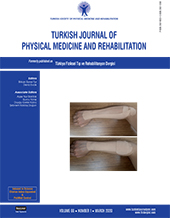The effect of physical therapy and rehabilitation modalities on sleep quality in patients with primary knee osteoarthritis: A single-blind, prospective, randomized-controlled study
Patients and methods: Between January 2017 and June 2017, a total of 40 patients (9 males, 31 females; mean age 56.6±8.9 years; range, 40 to 70 years) who were diagnosed with knee OA according to the American College of Rheumatology (ACR) criteria and were in Kellgren- Lawrence Grade 2-3 were included in the study. The patients were divided into two groups equally. Both groups received 15 sessions of exercise therapy, whereas the intervention group also received 10 consecutive physical therapy sessions in the form of hot pack, therapeutic ultrasound (US), and transcutaneous electrical nerve stimulation (TENS) by a single physiotherapist. Isometric and isotonic exercises were planned as 10 reps for three times a day as a home-based program. Clinical assessments were performed using the visual analog scale (VAS), Western Ontario and McMaster Universities Osteoarthritis Index (WOMAC), Beck Depression Inventory (BDI), Pittsburg Sleep Quality Index (PSQI), Epworth Sleepiness Scale (ESS), and Short Form 36 (SF-36) before and after treatment.
Results: Pre-treatment VAS, ESS, PQSI, BDI, WOMAC, and SF-36 scores showed no significant difference between the groups, whereas post-treatment scores showed a significant difference in the intervention group (p<0.05). The difference between the pre- and post-treatment VAS, ESS, PQSI, BDI, WOMAC, and SF-36 scores were significantly higher in the intervention group, compared to the controls (p<0.05).
Conclusion: Our study results show positive effects of exercise and physical therapy modalities on pain, disease activity, sleep quality, depression, and quality of life in knee OA patients.
Keywords : Physical therapy modals, primary knee osteoarthritis, sleep quality
















